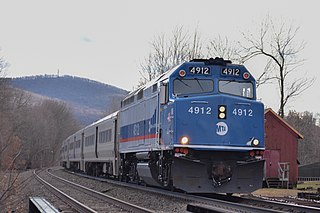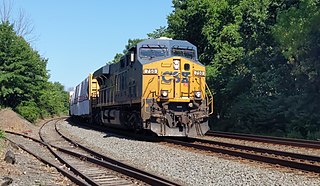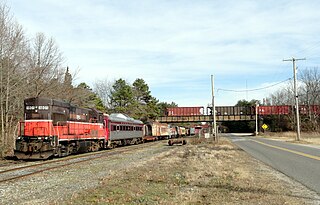
Metro-North Railroad, trading as MTA Metro-North Railroad, is a suburban commuter rail service operated by the Metropolitan Transportation Authority (MTA), a public authority of the U.S. state of New York. Metro-North serves the New York Metropolitan Area, running service between New York City and its northern suburbs in New York and Connecticut, including Port Jervis, Spring Valley, Poughkeepsie, Yonkers, New Rochelle, Mount Vernon, White Plains, Southeast and Wassaic in New York and Stamford, New Canaan, Danbury, Bridgeport, Waterbury, and New Haven in Connecticut. Service in Connecticut is operated under contract with the Connecticut Department of Transportation. Metro-North also provides local rail service within the New York City boroughs of Manhattan and the Bronx.

The Northeast Corridor (NEC) is an electrified railroad line in the Northeast megalopolis of the United States. Owned primarily by Amtrak, it runs from Boston in the north to Washington, D.C. in the south, with major stops in Providence, New Haven, Stamford, New York City, Newark, Trenton, Philadelphia, Wilmington, and Baltimore. The NEC closely parallels Interstate 95 for most of its length. Carrying more than 2,200 trains a day, it is the busiest passenger rail line in the United States by ridership and service frequency.

The River Line is a hybrid rail line in southern New Jersey that connects the cities of Camden and Trenton, New Jersey's capital. It is so named because its route between the two cities is parallel to the Delaware River.

The Delaware, Lackawanna and Western Railroad, also known as the DL&W or Lackawanna Railroad, was a U.S. Class 1 railroad that connected Buffalo, New York, and Hoboken, New Jersey, and by ferry with New York City, a distance of 395 miles (636 km). The railroad was incorporated in Pennsylvania in 1853, and created primarily to provide a means of transport of anthracite coal from the Coal Region in Northeast Pennsylvania to large coal markets in New York City. The railroad gradually expanded both east and west, and eventually linked Buffalo with New York City.

The Erie Lackawanna Railway, known as the Erie Lackawanna Railroad until 1968, was formed from the 1960 merger of the Erie Railroad and the Delaware, Lackawanna & Western Railroad. The official motto of the line was "The Friendly Service Route".

NJ Transit Rail Operations is the rail division of NJ Transit. It operates commuter rail service in New Jersey, with most service centered on transportation to and from New York City, Hoboken, and Newark. NJ Transit also operates rail service in Orange and Rockland counties in New York under contract to Metro-North Railroad. The commuter rail lines saw 57,179,000 riders in 2023, making it the third-busiest commuter railroad in North America and the longest commuter rail system in North America by route length.
Conrail Shared Assets Operations (CSAO) is the commonly used name for modern-day Conrail, an American railroad company. It operates three networks, the North Jersey, South Jersey/Philadelphia, and Detroit Shared Assets Areas, where it serves as a contract local carrier and switching company for its owners, CSX Transportation and the Norfolk Southern Railway. When most of the former Conrail's track was split between these two railroads, the three shared assets areas were kept separate to avoid giving one railroad an advantage in those areas. The company operates using its own employees and infrastructure but owns no equipment outside MOW equipment.
The United New Jersey Railroad and Canal Company (UNJ&CC) was a United States-based railroad company established in 1872. It was formed by the consolidation of three existing companies: the Camden and Amboy Railroad, Delaware and Raritan Canal Company, and New Jersey Rail Road and Transportation Company. The Camden and Amboy and New Jersey Rail Road were among the earliest North American railroads. The Pennsylvania Railroad leased the United New Jersey Railroad and Canal Company in 1872.

Conrail, formally the Consolidated Rail Corporation, was the primary Class I railroad in the Northeastern United States between 1976 and 1999. The trade name Conrail is a portmanteau based on the company's legal name. It continues to do business as an asset management and network services provider in three Shared Assets Areas that were excluded from the division of its operations during its acquisition by CSX Corporation and the Norfolk Southern Railway.

Pan Am Railways, Inc. (PAR) is a subsidiary of CSX Corporation that operates Class II regional railroads covering northern New England from Mattawamkeag, Maine, to Rotterdam Junction, New York. Pan Am Railways is primarily made up of former Class II regional railroads such as Boston and Maine Corporation, Maine Central Railroad Company, Portland Terminal Company, and Springfield Terminal Railway Company. It was formerly known as Guilford Transportation Industries and was also known as Guilford Rail System. Guilford bought the name, colors, and logo of Pan American World Airways in 1998.

The Port Jervis Line is a predominantly single-track commuter rail line running between Suffern and Port Jervis, in the U.S. state of New York. At Suffern, the line continues south into New Jersey on NJ Transit's Main Line. The line is operated by NJ Transit Rail Operations under a contract with Metro-North Railroad (MNRR).

The Conrail Lehigh Line is a railroad line in New Jersey that is part of Conrail Shared Assets Operations under the North Jersey Shared Assets Area division. The line runs from CP Port Reading Junction in Manville to Oak Island Yard in Newark. The line is double-track and signaled through its entire length. The line began operations in 1999 using former existing tracks from Manville to Newark that was once part of the original Lehigh Line which is still in existence and is owned and operated by Norfolk Southern Railway.
This article contains a list of terms, jargon, and slang used to varying degrees by railfans and railroad employees in the United States and Canada. Although not exhaustive, many of the entries in this list appear from time to time in specialist, rail-related publications. Inclusion of a term in this list does not necessarily imply its universal adoption by all railfans and railroad employees, and there may be significant regional variation in usage.
Standards for North American railroad signaling in the United States are issued by the Association of American Railroads (AAR), which is a trade association of the railroads of Canada, the US, and Mexico. Their system is loosely based on practices developed in the United Kingdom during the early years of railway development. However, North American practice diverged from that of the United Kingdom due to different operating conditions and economic factors between the two regions. In Canada, the Canadian Rail Operating Rules (CROR) are approved by the Minister of Transport under the authority of the Railway Safety Act. Each railway company or transit authority in Canada issues its own CROR rulebook with special instructions peculiar to each individual property. Among the distinctions are:

The Southern Railroad of New Jersey is a small short-line railroad company based in Winslow Township, New Jersey. The railroad operates freight trains in two areas in Southern New Jersey. In the Winslow area, trains operate between Winslow Junction and Pleasantville, and between Winslow Junction and the Winslow Hot Mix asphalt plant in Winslow Township. In Gloucester County, the company operates on the Salem Branch between Swedesboro, New Jersey and Woodbury.
The General Code of Operating Rules (GCOR) is a set of operating rules for railroads in the United States. The GCOR is used by Class I railroads west of Chicago, most of the Class II railroads, and many Short-line railroads.

Pulse code cab signaling is a form of cab signaling technology developed in the United States by the Union Switch and Signal corporation for the Pennsylvania Railroad in the 1920s. The 4-aspect system widely adopted by the PRR and its successor railroads has become the dominant railroad cab signaling system in North America with versions of the technology also being adopted in Europe and rapid transit systems. In its home territory on former PRR successor Conrail owned lines and on railroads operating under the NORAC Rulebook it is known simply as Cab Signaling System or CSS.

Morristown & Erie Railway is a short-line railroad based in Morristown, New Jersey, chartered in 1895 as the Whippany River Railroad. It operates freight rail service in Morris County, New Jersey and surrounding areas on the original Whippany Line between Morristown and Roseland, as well as the Morris County-owned Dover & Rockaway Branch, Chester Branch, and High Bridge Branch. The M&E also operated the Maine Eastern Railroad from November 2003 to December 31, 2015.

The Lehigh Line is a railroad line in Central New Jersey, Northeastern Pennsylvania, and the Lehigh Valley region of eastern Pennsylvania. It is owned and operated by the Norfolk Southern Railway. The line runs west from the vicinity of the Port of New York and New Jersey in Manville, New Jersey via Conrail's Lehigh Line to the southern end of Wyoming Valley's Coal Region in Lehigh Township, Pennsylvania.

The New York Branch or the Bound Brook Route was a railway line in Pennsylvania and New Jersey. It was operated by the Reading Company and owned by two of its subsidiaries, the North Pennsylvania Railroad and the Delaware and Bound Brook Railroad. It formed part of the Reading's route from Philadelphia to New York City, used by the famed Crusader. The line was transferred to Conrail in 1976 and was split into the Neshaminy Line and Trenton Line. SEPTA continues to operate commuter trains to West Trenton as part of its West Trenton Line.














